In a time where flagship devices are crossing price tags of $1,000, the budget flagship market is one of the hottest segments of the market. Ever since the launch of their first device, OnePlus has maintained their crown as the “flagship killer”. Now, with the launch of the Honor View 10, Honor aims to steal the crown from right under OnePlus’ nose.
The Honor View 10 comes with the latest specs and a ton of other features. But apart from all that, the device comes fused with an integrated NPU for efficient Artificial Intelligence features. And at a price tag of just 30,000, the Honor View 10 offers a staggering value for money on paper. But does the device actually live up to its expectations, and does OnePlus finally have a worthy competitor? Let’s find out as we bring to you our in-depth review of the Honor View 10:
Honor View 10 Specifications
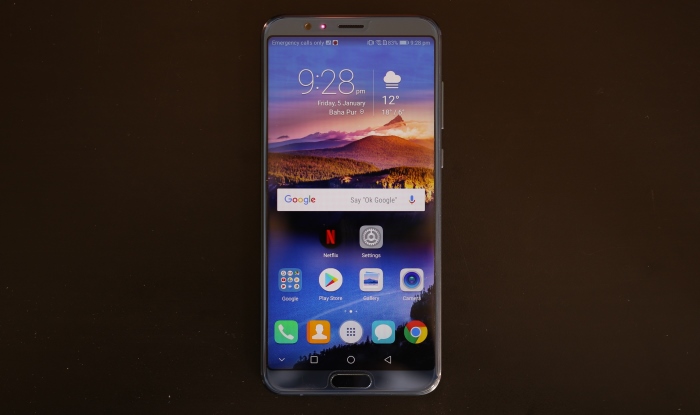
Before we get started with the review, let us get the specifications out of the way. The Honor View 10 shares a lot with the Huawei Mate 10, offering a compelling mixture of the latest and greatest hardware and software in a beautiful package. Check out the details below:
| Display | 15.21cm (5.99 inch), Full View FHD + (1080p x 2160p) |
| Camera | Rear: 16MP+20MP |
| Front | 13MP |
| Memory | 6 GB RAM + 128 GB ROM |
| Processor | Huawei Kirin 970, Octa-Core (4*2.36Ghz + 4*1.8Ghz) |
| OS+UI | Android8.0 + EMUI8.0 |
| Battery | 3750mAh |
| Dimension | 157.00 mm (L) x 74.98 mm (W) x 6.97mm (T) |
| Weight | 172g (Including the battery) |
| Expandable Memory | Micro-SD, up to 256 GB |
| Audio | Bottom Speaker |
| Sensor | Fingerprint sensor, Digital compass, Ambient light sensor, Accelerometer, Status indicator |
| Bluetooth | BT4.2+BLE, |
| WiFi | 802.11 b/g/n, 2.4GHz, 802.11a/n/ac, 5GHz, |
| GPS | GPS/AGPS/GLONASS/BDS, |
| NFC | Support NFC, Wi-Fi Direct, |
| Colour | Navy Blue, Midnight Black |
What’s In The Box
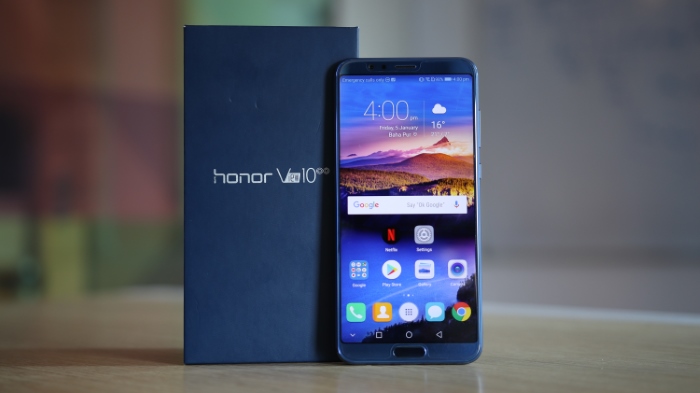
The Honor View 10 comes with a simple packaging, with no unnecessary hassles. The box feels premium and the unboxing process was quite satisfying. The box itself has the device and all the basic stuff that you’d expect along with it. The only thing missing from the packaging were a pair of earphones, though it has kind of become a standard amongst smartphone manufacturers to not include them.
- Honor View 10 device
- Scratch-Resistant Screen guard (pre-applied on the device)
- Huawei Quick Charger
- USB-A to USB-C cable
- Protective Silicon Clear Case
- User Manual
Design and Build Quality
We start off with the most prominent part of the Honor View 10, and that is the overall design and build quality. The front of the device resembles the Mate 10, with the same 18:9 display coupled with minute bezels along with a glossy finish on top of it. There’s also a fingerprint scanner underneath the screen, which feels like it has been squeezed into the frame. While I’ll get to this later on, the device looks absolutely stunning from the front side.
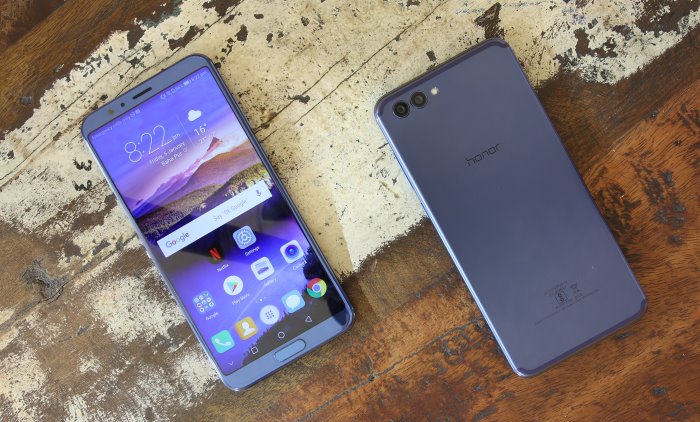
On the rear end, there’s not much to talk about. The top-left corner houses the dual lens camera setup accompanied by the LED flash. The back has the “honor” branding in the middle portion, with the FCC licensing info on the bottom. There are noticeable antenna lines on both the top and bottom ends of the device, that while being functional, also add to the overall look of the device. All in all, the matte finish back looks great and feels great to hold as well.
The left side of the smartphone has the hybrid SIM tray that holds 2 SIM cards or 1 SIM card accompanied by a microSD card of up to 256GB. On the right side, we have the volume rockers, followed by the power button. The top edge of the device has the IR blaster coupled with a mic for noise cancellation. It is nice to see Honor include an IR blaster on the View 10, a feature that many flagship devices also don’t sport.

On the bottom end, we have the USB Type-C port, sandwiched between the 3.5mm headphone jack and the speaker. Basically, the Honor View 10 has all the ports that you’d expect from a flagship device, and then some.
The device feels absolutely great in hand, and scores very high on the design and build quality front.
The overall form factor of the device is quite minimal. The device, although sleek, feels quite sturdy in hand, while maintaining the feel of being a premium device. While everything is top-notch and near perfect, I personally feel that the fingerprint sensor could have been shifted to the back side rather than cramping it in the bottom end of the front of the device. It’s basically the same argument as it is between the Huawei Mate 10 and the Mate 10 Pro, whether to have the fingerprint sensor on the front or on the back. Despite that, the device feels absolutely great in hand, and scores very high on the design and build quality front.
Display
The latter half of 2017 saw the rise of 18:9 bezel-less displays and the same trend has followed in 2018. With the Honor View 10, the company has brought about one of the most beautiful looking displays on the market. The 18:9 bezel-less display on the View 10 is as stunning as it looks, and manages to capture the viewer’s attention almost immediately.

The panel used is an LTPS IPS LCD display with FHD+ (2160x1080p) resolution. What’s interesting here is that Honor gives its users an option to lower down the resolution to 1440x720p in order to conserve battery. While Samsung has sported this feature on their devices for quite some time, it is nice to see other companies also follow this path.

The Honor View 10 comes as a direct competitor to the OnePlus 5T. In terms of display, it is a different ball game altogether. The OnePlus 5T sports an AMOLED display which boasts of rich colors and high color gamut. The View 10, on the other hand, boasts of a wider view range with a promise of no burn-in issues ever. Personally, I prefer AMOLED displays more, but then that’s my opinion.
If you fancy the LCD screens more, surely the View 10 would appeal to you more.
While the display looks absolutely stunning nonetheless, the only complaint I had with Honor is the fact that the View 10 does not include any sort of display protection. Yes, that’s right. And I feel that’s just a shame. Even though I did not experience any sort of scratches as I feared in my daily usage, the omission of any sort of Corning Gorilla Glass protection is definitely puzzling. Especially considering a price tag of 30,000. The company was nice enough to provide a scratch-resistant screen guard in the box that is pre-applied onto the unit, but to be honest, that won’t be enough for everyone. As such, I would highly recommend getting a tempered screen protector for your Honor View 10, as it would be a shame to have that beautiful 5.99-inch display cracked up.
User Interface and Experience
When you’re using a device, the overall user interface can make or break your entire user experience. The Honor View 10 ships with Android 8.0 Oreo out-of-the-box with Honor’s EMUI skin on top of it. Before I talk about EMUI, it is worth noting that the device does come with the latest version of Android, which is quite frankly a nice touch. The View 10’s main competitor, the OnePlus 5T, despite boasting of great hardware and near stock experience, comes with Android Nougat only, with the beta builds of Android Oreo to be released soon. As such, the Honor View 10 scores above the OnePlus 5T, at least in terms of having the latest Android version.

Now that we’ve addressed that, let’s dive into EMUI. My past experience with EMUI was on my Honor 6X, that debuted with EMUI 5.0 based on Android Nougat. Drawing comparisons with the same, the Honor View 10 with the EMUI 8.0 on it feels exactly the same. There are barely any visual changes between the two OSes, except for a few added tweaks. The EMUI 8.0 skin is essentially EMUI 5.0 powered by Artificial Intelligence, which happens to be the key point of the Honor View 10.
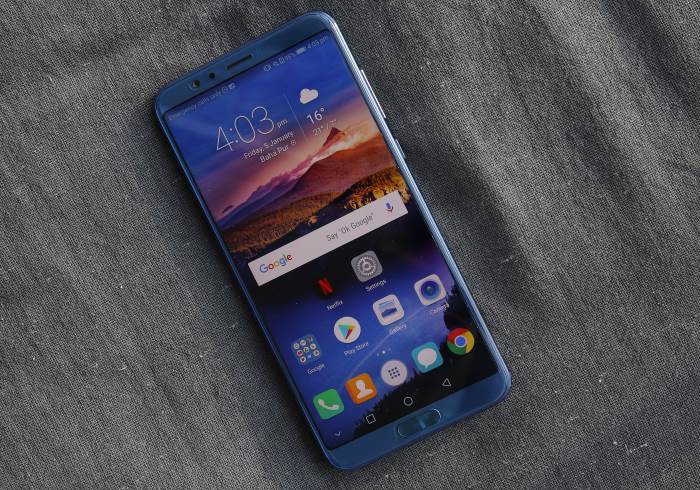
The EMUI 8.0 maintains the same overall design language as seen on EMUI 5.0. The new notification panel, the use of vibrant colors, and a couple of other features such as App Twin, Eye Comfort mode, One-handed UI, and more are present, all jumbled up within Huawei’s various menus. Apart from that, EMUI 8.0 brings Navigation Dock, which basically resembles the iOS quick-touch, but with a different function. You can use various gestures on the “white-ball” to navigate your device. Why Honor went ahead to name it a “dock” is beyond my understanding, and the feature itself is sort-of gimmicky rather than being that practical.

Including the aforementioned navigation dock, the device offers a total of 3 navigation modes, that are an on-screen navigation bar and gesture navigation on the fingerprint scanner. Personally, I found myself using the standard softkey or on-screen navigation bar only. Honor’s navigation dock might still appeal to some users, but the fingerprint scanner is just a big no. The biometric scanner is awkwardly placed under the screen and is highly uncomfortable to use. It might be someone’s cup of tea, but I personally felt it would have been better to have placed the fingerprint scanner on the back side, as it is on the Honor 7X or the Huawei Mate 10 Pro.

Finally, EMUI 8.0 brings forth the inclusion of AI into the OS. According to Honor, “Based on machine learning, EMUI 8.0 allocates resources dynamically to give more CPU and memory to the apps actually used in order to ensure a smooth experience.”. Now here’s the thing – at the time of writing this review, the device was barely a week old. Machine learning is great, but it is supposed to show its effect in time. The whole idea of embedding machine learning AI onto the device coupled with an NPU was to ensure that the device lasts longer than an ideal device that would start showing signs of slowing down in a couple of years, give-or-take a few months. Although I was able to notice slight improvements here and there after a week of usage, the device was still pretty much new, so there isn’t enough concrete evidence on my part to state whether the company’s claims are right or not. That being said, my first impressions were certainly in line with Honor’s promises.
My first impressions with the View 10’s AI were certainly in line with Honor’s promises.
While most of the features are great, there were some points where I felt the Honor View 10 lacked in terms of the interface and features provided. To begin with, EMUI 8.0 came with Huawei’s implementation of the dockless PC Mode. While the feature did debut with the Mate 10 and the Mate 10 Pro, it was also made available on the Mate 9 when it got updated to the EMUI 8.0. As such, I was really excited to see a relatively lower-priced device sport this feature, considering it ships with EMUI 8.0 as well. Sadly, the View 10 has no PC mode, and it did leave me wanting for more.
While EMUI 8.0 came with the promise of a dockless PC mode, sadly this feature was missing from the Honor View 10.
Another disappointment I faced with the View 10 was the fact that it had Face ID but implemented in a rather different way. While Apple and OnePlus use it as a biometric for unlocking the device, Honor uses Face ID to simply uncover the full notification content on your lock screen. I would not rule out the fact that it is practical in some ways, but I did wish that there was a better implementation of the Face ID. Thankfully, the company did state that they will soon be rolling out an OTA update that would include the face unlock feature, so I’ll just keep my fingers crossed.
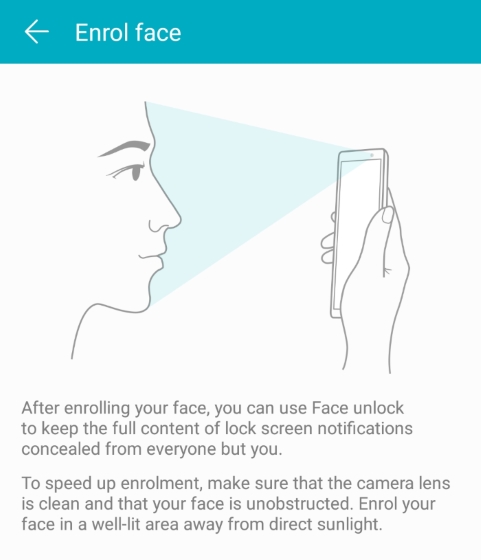
All in all, for someone who likes to explore, EMUI is something you’ll get accustomed to in time. It offers almost the same user experience of MIUI while being considerably light on resources. That being said, for a stock Android lover, it might be a different story altogether.
EMUI is still miles away from the way Google imagines Android to be and could be a deal breaker for AOSP lovers.
Camera
The Honor View 10 comes with a rear dual lens setup that offers a wide aperture ranging from f/.95 to f/16. Now those are some crazy numbers, and naturally, I was quite excited to test out this amazing setup.
In a nutshell, I wasn’t disappointed by the performance in well-lit conditions by any means. Low-light conditions, however, were a different story altogether.
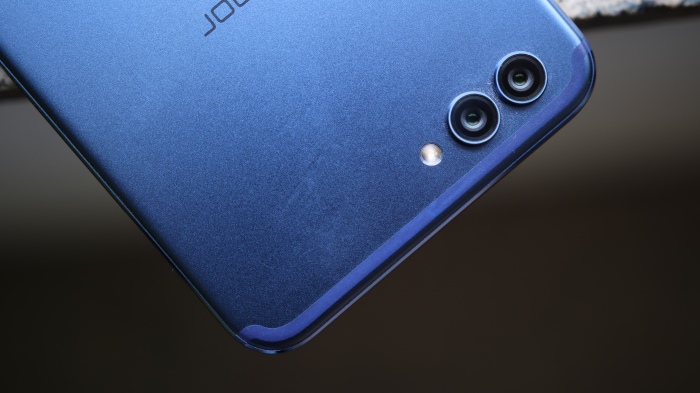
Before I get to the actual quality of the images and videos, let us talk about the camera app itself. I’ve always applauded Huawei/Honor for the amazing camera app that comes pre-loaded onto their devices, and the Honor View 10 shares the same DNA. The stock camera app comes loaded with a plethora of features such as portrait mode, moving picture, panorama, time-lapse, and much more. What’s more is that it comes with a proper “pro-more” for both still images and videos. Yes, that’s right, you get a pro mode for videos too. Another new addition to the camera app is the inclusion of AR stickers as well, that are included in the camera app only.

Now let’s talk about the image quality. The 2 lenses on the View 10 aren’t Leica lenses like the Mate 10, so maybe you don’t have a great brand to brag about. That being said, the image quality in itself should grant you enough bragging rights. The camera manages to produce images with rich colors and pixel-perfect sharpness. There is no loss in quality even while zooming at high levels, and the overall color reproduction is great.

 Honor has implemented a portrait mode in the camera as well, but it uses both the dual camera setup as well as the embedded NPU for AI capabilities. The results are absolutely stunning, to say the least. The edge detection is almost right-on, and the blurring feels is just the right amount. I have always found the portrait mode on smartphones to be a software gimmick, but the View 10 is one of the rare devices that actually manages to produce a natural depth effect. Yes, the Pixel 2 is still by far the best camera, but the Honor View 10 isn’t far behind. Honor’s monochrome+RGB combination works very well and doesn’t miss out on any details whatsoever.
Honor has implemented a portrait mode in the camera as well, but it uses both the dual camera setup as well as the embedded NPU for AI capabilities. The results are absolutely stunning, to say the least. The edge detection is almost right-on, and the blurring feels is just the right amount. I have always found the portrait mode on smartphones to be a software gimmick, but the View 10 is one of the rare devices that actually manages to produce a natural depth effect. Yes, the Pixel 2 is still by far the best camera, but the Honor View 10 isn’t far behind. Honor’s monochrome+RGB combination works very well and doesn’t miss out on any details whatsoever.

Unfortunately, all the praises for the camera are only limited to daylight or well-lit conditions. Turn off the lights and you can see the camera’s weakness. The low-light performance of the Honor View 10 is just above average, with noise starting to creep in. Images are lacking in detail quality, and the overall tone is soft rather than being sharp. It is in this scenario where I found my OnePlus 5T to be a better performer, which uses the dual lens setup in a different way to enhance low-light photography.

The front 13MP camera is also great, in most cases. The images are mostly soft, but the AI based portrait mode works very well. There’s also a beauty mode present to bring out the glow in one’s face, though I personally wasn’t fond of this feature as it resulted in unrealistic images. In low-light conditions, the camera just wasn’t able to keep up and left me disappointed overall.

Overall, the real camera setup is absolutely great, but only when limited to well-lit conditions. Switch to low-light conditions or the front camera in general, and the image quality takes a steep downfall. I still feel that these are software related issues, and probably can or will be fixed it in the future updates, as was the case with the Essential phone.
Performance
The Kirin 970 processor is an in-house developed processor from Huawei that goes head-to-head with Qualcomm’s current flagship SoC – Snapdragon 835. But what truly sets it apart is the combined use of an NPU that makes it a future-forward processor.
For those people who rely on numbers, the Honor View 10 performs astoundingly well in stress-testing benchmarks. We got a score of 174,327 in the Antutu Benchmark while scores of 1,919 and 6,633 in single-core and multi-core tests by Geekbench. Recently, there were reports of the Kirin 970 outperforming the upcoming Snapdragon 845 by almost 7%. While I personally did not see any such results in the Honor View 10’s testing, it does come at par with the current Snapdragon 835.
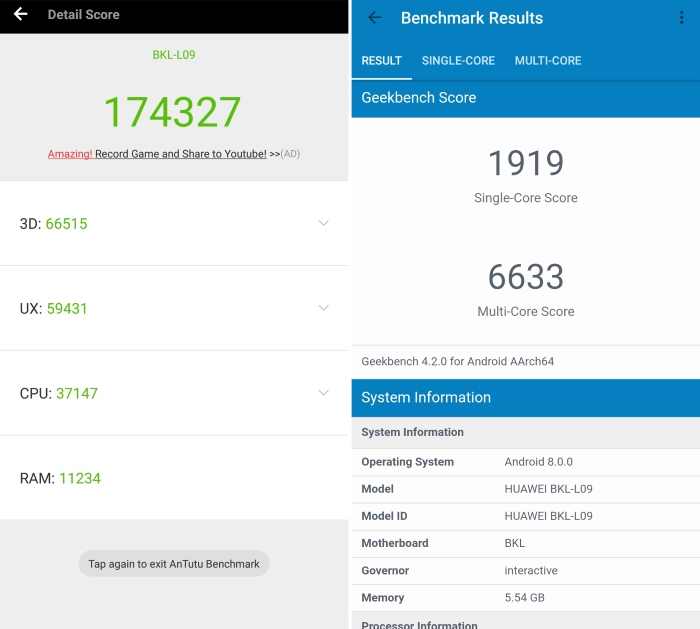
That being said, I’ve always urged my readers to understand that benchmarks are not always the actual measurement of a device’s performance. In day to day life, the average consumer’s usage is not remotely close to that of a stress test. It is, with this understanding, I say that the Honor View 10 actually outsmarts a lot of its competitors.
The 6GB RAM coupled with the advanced Kirin 970 processor doesn’t let you down even in the most demanding of situations.

Multitasking was a breeze on this device, and I faced absolutely no issues whatsoever. The custom built Mali-G72 MP12 GPU also performs very well. I tried playing graphics intensive games such as Asphalt 8, PES 2018, and Shadow Fight 3, and the device showed no signs of lag.
Not only does the 18:9 bezel-less display makes game visuals pop-out, but thanks to the powerful specs, the performance is butter-smooth.
All in all, the Kirin 970 gives the current crop of flagships a run for their money. The performance is absolutely great, and with the combined use of AI, it is only going to get better (or at least maintain the same high level) as time goes by.
Connectivity
The Honor View 10 manages to check all the points in terms of what all ports there should be on your smartphone. It’s 2018, so definitely there should be a USB Type-C port, and the View 10 has that. You want to listen to your music collection, but still, haven’t adopted the wireless standards? No worries, the View 10 has a 3.5mm headphone jack as well. But if you want to go the Bluetooth way, the device comes with Bluetooth 4.2 combined with A2D and aptX HD.
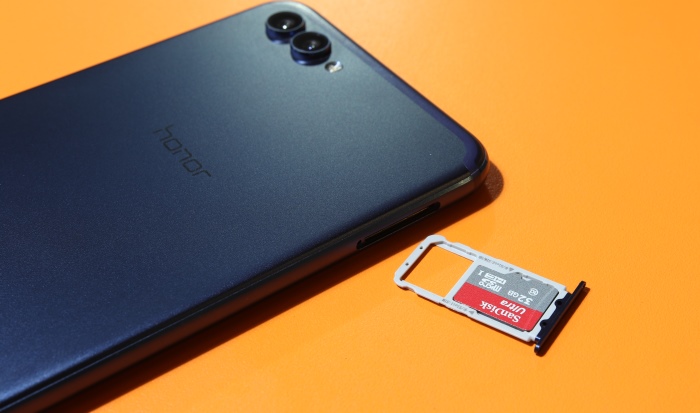
In the current trend of mid-rangers and budget-flagship devices, dual-SIM devices have started to flourish a lot. Thankfully, the Honor View 10 has got your back on that end as well, supporting two nano-SIM cards at the same time. It’s main competitor, the OnePlus 5T, while being great, does lose out on the microSD card front, a feature that’s present in the View 10. Oh, and apart from Xiaomi’s devices, the Honor View 10 is one of the rare few devices to also sport an IR blaster, which I personally found to be a nice addition.
Battery
For anything that’s portable, battery life is a big concern. The Honor View 10 comes with 3,750mAh battery coupled with Honor Supercharge. The company claims that the device charges at a 9V/2A rate, but I personally never experienced that in my review unit. Owing to the company’s boastful claims of fast charging, I expected a charging speed comparable to the OnePlus 5T’s Dash Charging. Needless to say, when the device took over 2 hours to completely charge, I was left disappointed.
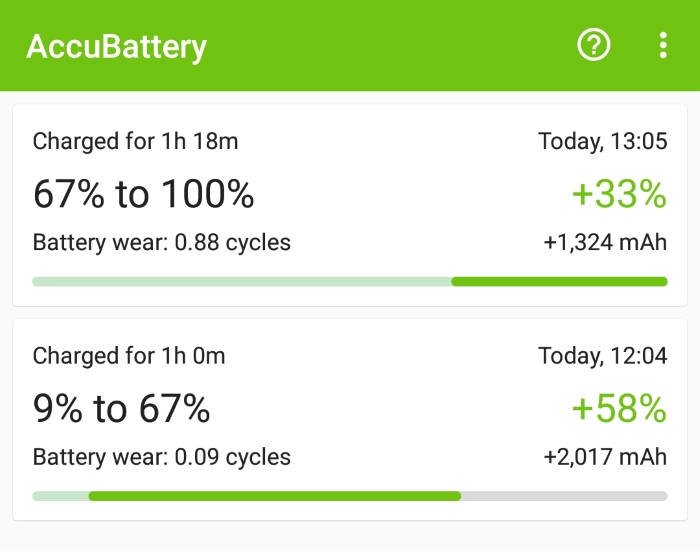
But that is just the charging front. The overall battery life is, fortunately, a different story. In my usage of the device which included watching some Anime, playing the usual games, lots of calls, and a ton of surfing on Twitter; the device managed to easily last throughout the day, while still retaining some juice.
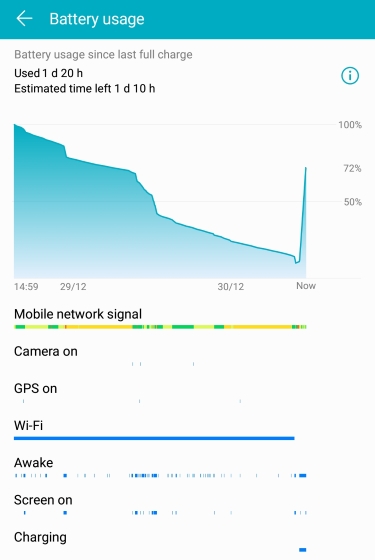
I think along with the huge battery capacity, the OS also deserves its fair share of praise. EMUI 8.0 is extremely good at battery management, and the different battery saving modes coupled with a change in resolution could easily allow one to push their device to higher battery life numbers.
Artificial Intelligence
The main USP of the Honor View 10 has been the inclusion of a future-forward processor, that makes use of artificial intelligence to provide better performance. The Kirin 970 is the same processor that is present on the Huawei Mate 10 and Mate 10 Pro devices, a processor that has been designed from the ground up for AI. According to the company, the Neural Processing Unit (NPU) inside the 970 enables AI features to occur locally, instead of over the cloud. This allows the system to process and utilize AI features faster, while also maintaining the user’s privacy.

In my experience with the device, the existence of AI was very slight (considering I used it for merely a week), but it was evident. Face detection in my selfies improved with constant use, and edge-blurring eventually started becoming much more accurate. My frequently used apps such as WhatsApp and Twitter began to load faster than usual, and there was a noticeable shift in the overall performance of the device. I know it sounds really futuristic, but I could definitely feel the device adapt to my usage style.
I could feel the device adapt to my usage style.
The company claims that the embedded NPU should help the device last longer than your usual smartphone. It is still quite early to confirm that, though, with my limited usage, I could sense the truth behind that statement. If that actually does turn out to be true, the Honor View 10 sounds like a compelling deal at 30K, considering it is a device that should last me more than a couple of years.
Honor View 10: Should You Buy It?
Well, we’ve discussed the amazing screen, the stellar performance, and decent battery life. We’ve talked about the implementation of AI, and how the device should hold itself in the coming years. So, is the Honor View 10 the perfect choice for you? In many ways, I’d say – yes. It absolutely is. It comes as a direct competitor to the OnePlus 5T. But standing 3,000 rupees cheaper than the 6GB variant of the 5T, the Honor View 10 offers almost everything similar, with a few extra additions which include a bigger ROM, support for expandable storage, and a camera that performs better in broad daylight. On the downside, you’ll have to live with a feature-packed but heavily skinned UI that’s still way different than the stock AOSP experience offered by OxygenOS.
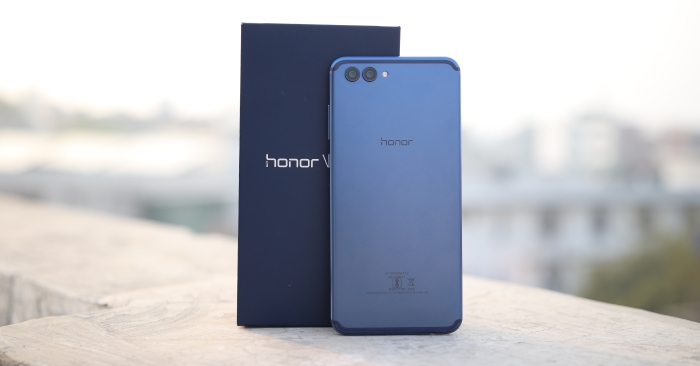
To me, the Honor View 10 offers a staggering value for money at 30,000, and one can’t really go wrong with it. That being said, if you are a performance freak, and love the stock Android experience, the OnePlus 5T is a better option for you.
Pros:
- Appealing Design and Build Quality
- Great 18:9 display
- Amazing Cameras with AI
- Blazing fast performance
Cons:
- EMUI is still far away from Stock Android
- Some AI features are gimmicky
- Awkward placement of fingerprint sensor
- Low-light performance is sub-par
Buy Honor View 10: (Rs. 29,999)
SEE ALSO: Honor V10 Registrations Begin on Amazon India
Honor View 10: Your First AI Phone
Honor has managed to bring out a device that will certainly appeal to a majority of consumers. For a couple of years, OnePlus has ruled the budget-flagship segment, while giving heavy competition to the flagship OEMs. Now, with the Honor View 10, there is finally a decent competitor to shake OnePlus off its throne. The device comes with a great hardware bundled with some pretty useful and some gimmicky features. Furthermore, the inclusion of AI on the View 10 separates it from the herd and makes it a worthy choice. Having used the device, I can say that AI is indefinitely the future of mobile computing, and the Honor View 10 is a great first step in that direction. Well, that’s the end of my review, do tell us your thoughts about the smartphone by dropping them down in the comments section below.


















